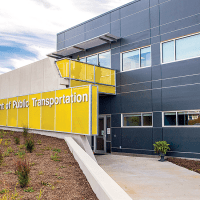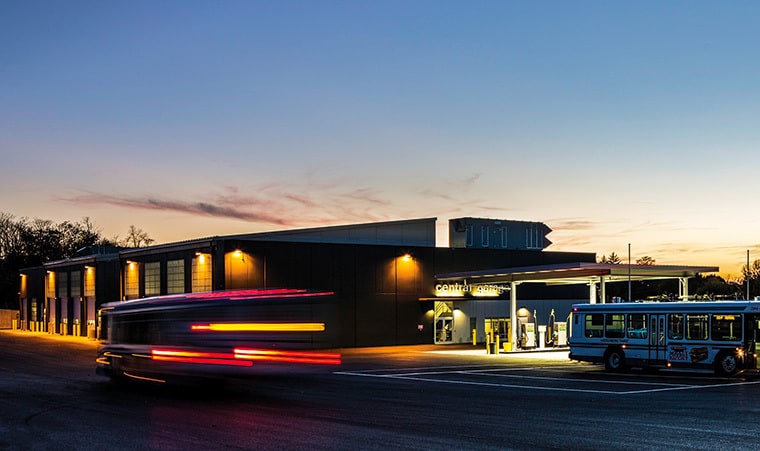This article was first published in December 2015 by Engineering News-Record Mid-Atlantic.
HARRISONBURG, Va. — Located on a 16-acre shared-use site, Harrisonburg’s new transit center is a hub of activity. A new 29,247-sq-ft maintenance and wash building allows the city of Harrisonburg to maintain approximately 650 city vehicles, 43 school buses, 38 transit buses and 10 mini buses. The 12,678-sq-ft administration and operations building houses 160 full- and part-time employees.
The site’s topography required the team to construct the administration facility into the hillside with the building acting as a retaining wall. The design addresses circulation and security constraints on the dramatically sloping site. Administrative staff and visitors enter and occupy the second level, where the main entrance is located. The areas for operations staff and drivers are on the lower level.
Bringing sufficient natural light into the building was a critical goal for the team. While the east side of the building is built into the hillside, large expanses of glass open toward the west with views of other existing buildings on the site as well as the mountains beyond. Offices and occupied spaces are located along the glass facade. Glazing is shaded with prefabricated metal canopies. A light monitor at the centralized open stair brings daylight deep into the building. Light sensors were incorporated so that lights turn off after 10 minutes of inactivity.
The maintenance building also maximizes the use of natural light in the repair bays. Translucent sandwich panels let refracted light into the maintenance shop and the building facade and, through full-length clerestories, at service areas. Slab-on-grade concrete in the maintenance repair bays has a reflective hardener that helps illuminate the underside of raised vehicles as light bounces off the floor. It also has increased abrasion resistance when tools are dropped. The maintenance shop has LED lighting and uses photocell sensors.
Precast panels were used for the structure, minimizing onsite construction time and providing the durability needed to operate a transportation facility. The wash bays have a reuse/reclaim water system to conserve an otherwise water-intensive operation. The maintenance facility also uses recycled motor oil to heat the building.
Existing department operations at the site had to remain fully operable and services could not be interrupted during construction.
Crews performed 96,277 work hours with no lost-time accidents.
Harrisonburg Dept. of Public Transportation Administration and Maintenance Facility — Harrisonburg, Va.

Photo by Garrett Strang
Key Players
Owner Harrisonburg Dept. of Public Transportation
Design-Builder Howard Shockey & Sons (General Contractor); RNL (Prime Design Firm)
Structural/Civil/MEP Engineer Valley Engineering Surveying Planning
Facilities and Equipment Maintenance Design Group
Environmental Engineer Atkins Global
Read more at ENR Magazine

